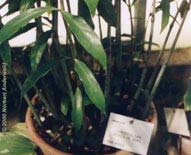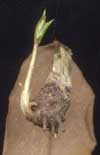A 'different' Zamioculcas |
I have seen a plant labelled as "Zamioculcas gracilis ENGL." (most likely a nom. nud.) in one of the greenhouses of the Giardino dei Semplici in Florence, Italy, in May 2001. It had the overall appearance of Z. zamiifolia, but was smaller in size - fully grown leaves about 50 to 60 cm long - and looked less xeromorphic. The leaf bases were not inflated; the leaflets (pinnae) did not show the intensive gloss and dark green colour of Z. zamiifolia, but were softer, thinner and less succulent in appearance and texture (reminding somehow of the leaves of e.g. Pereskia, Cactaceae), and narrower in shape, with an elongated tip (Z.z.'s leaflets are more ovoid and with a much shorter tip). A very distinctive characteristic of this plant is the conspicuous 'knee', a thickening in the leaf petiole (similar to Gonatopus), which is located right below the point of transition from the (elongated) leaf base to the petiole (leaf stalk). The "normal" Zz has a similar discontinuity in the leaf axis, which is hardly swollen and by far less conspicuous. Zz drops dead leaves near this point of transition, which is marked by a ring of dark coloured spots around the top of the leave base (see illustration).
The leaflets show a regenerative potential similar to those of Z. zamiifolia: formation of callus, roots, young tubers and apical meristem; this full regeneration can occur both at the base of the leaflet petiolule and at interruptions of the central vein of the leaflet blade. The observed cuttings did not develop a +/- globular tuber with fissured, cork-like cortex (like the 'normal' Zz), but showed softer skinned tubers of varying shape. The first leaf (after some tiny bracts) has two leaflets -like the 'normal' Zz-, but is much smaller. The plant appeared to be very sparsely covered with tiny hair of dark colour; but this observation may as well be explained as a misinterpretation of epiphytic algae. The observed plant in Firenze showed some infestation with mealy bugs. |
Orto Botanico dell'Universitą degli Studi di Firenze  "different" Zamioculcas in Firenze, May 2001  details, enlarged. note: leaflet form; thickening in leaf petioles (top right)  'different' Zamioculcas: young tuber, developing at the end of a leaflet petiolule, with first leaf |
| The leaves had a striking resemblance with the plant in this image of a young seedling. Note the mentioned swelling in the leaf axis. (The plant described above was already mature and densely foliated). The differences to a "normal" Zz. are clearly visible. |
Young seedling / mirror site © 1995 Krzysztof Kozminski |
|
Web references |
On the Internet, I found some references to a "different" Zamioculcas zamiifolia, mostly in newsgroups and on nursery pages. This is one of them, quoted here in full (© 1996-2001 Glasshouse Works):
Here's another one from the " The Philodendron Phreaque" (© 2000 Dewey Fisk, Plant Nut):
No web references to "Zamioculcas gracilis" at all. Most likely a nom. nud. (ENGLER does not mention it either...) |
|||
| publication: July 9, 2001 |
open navigation frame | last update: December 6, 2002 |